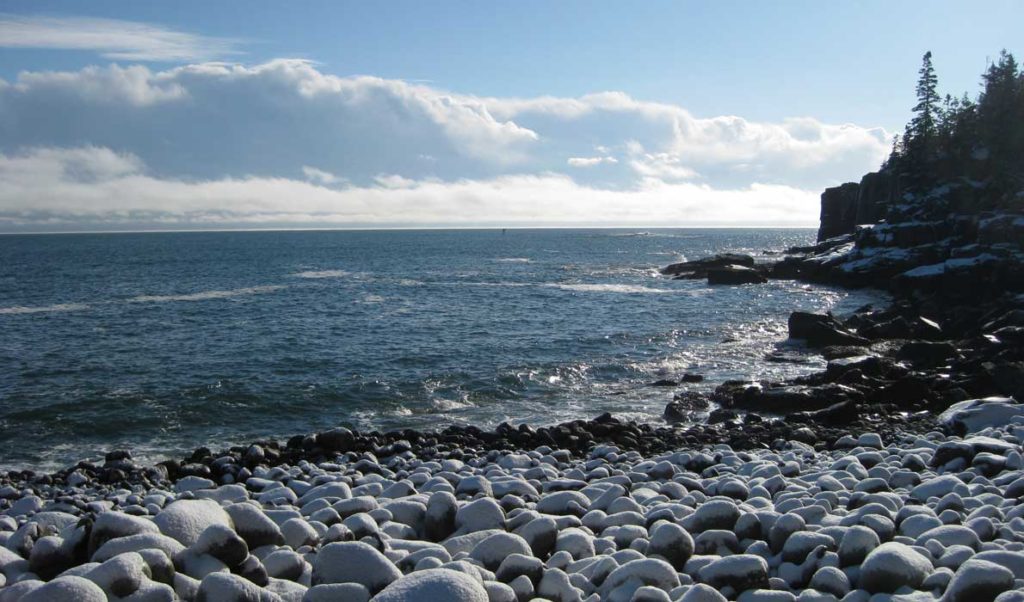By Aimee Beal Church
With some relatives in town this summer, my family and I swam at Echo Lake in Acadia National Park almost every day for a week. On a typical afternoon we’d stake out a little spot with our towels on the granite ledges at the bluffs, sharing the refreshing water with picnicking, sunbathing, shouting and splashing swimmers of all ages.
But on the last day of July, around 10:30 a.m. on a Sunday, we arrived to discover we had the place to ourselves. Quiet enough to hear the light breeze ruffling the needles of the white pines that tower, cathedral-like, above the sun-dappled rocks, the perfect tranquility recreated the intimate, soul-lifting Echo Lake experience I remember from my childhood.
That sort of experience is the exception during summertime at Acadia and, increasingly, in the shoulder seasons as well—when packed parking lots frustrate tourists and residents alike, and visitors fan out across fragile ecosystems in search of their own bit of solitude.
There’s been a lot of buzz about the possibility that Acadia will welcome more than three million visitors in 2016, its centennial year—which would be a leap of 20 percent from just two years ago, and an all-time record for the park. This may well be a temporary spike, but the fact is that crowding and congestion at Acadia have been increasing problems for years and are not likely to go away after the Acadia Centennial flags have been taken down from the storefronts of Bar Harbor.
National Park visitation is on the rise nationwide. More people means more cars in the parking lots, more wear and tear on park facilities, more need for park rangers and other safety personnel to manage dangerous or other situations, less chance of a peaceful, inspirational experience like I enjoyed at Echo Lake.
But crowding is not just a question of sheer numbers, but of how people visit the park. Compared to a few decades back, far more visitors get off the Loop Road and deep into the park by hiking the trails and biking the carriage roads. And social media’s ability to broadcast a personal experience means that one person’s “secret” spot can become everybody’s next destination in record time, stressing areas of the park that weren’t designed for crowds.
What are park managers to do? Acadia is in the middle of a multi-year transportation planning effort: studying problem locations and times, gathering community input on priorities, brainstorming and experimenting with solutions, and proposing and ultimately implementing changes in how visitation is managed.
Any change is sure to be welcome to some visitors and bemoaned by others; for the effort to succeed, community input and buy-in will be critical. So, too, the most creative and effective solutions may well have a price tag attached—it’s imperative that the park have the resources both to experiment and to implement its final plan.
That’s why the Acadia Centennial might actually help with crowding and congestion at Acadia.
As of this writing, 443 organizations, businesses and individuals have signed on as Acadia Centennial Partners to help put on this yearlong, community-based celebration. Add to that number the countless Acadia-area residents and visitors attending centennial events, purchasing centennial products, reading articles and books about the centennial and interacting on centennial social media.
The upwelling of affection for this unique corner of the Maine coast has the potential to build a more committed, more engaged relationship between the park and its surrounding communities.
When, in the coming years, Acadia asks for help—for public comment on its transportation plan, for compliance (enthusiasm, even!) on entry pass and parking changes, for advocacy to remind legislators of the federal responsibility to fund the national parks, or for continued philanthropic donations and volunteer support—the hope is more of us will feel a personal motivation to contribute. On the flip side, a more engaged community will be better positioned to give the park guidance as it contemplates transportation and other changes that may affect us all.
Acadia is our park. In this region of Maine, many of us benefit from Acadia as an economic engine and as an unparalleled recreational resource. We at Friends of Acadia are looking past the Acadia Centennial, to figure out where we go from here to assure that Acadia is protected for its second century and beyond, for the inspiration and enjoyment of all. We’re grateful that so many in our communities are ready to help us.
Aimee Beal Church is the communications director at Friends of Acadia and a lifelong resident of the Acadia National Park region.





